Tamilnadu State Board New Syllabus Samacheer Kalvi 11th Accountancy Guide Pdf Chapter 4 Ledger Text Book Back Questions and Answers, Notes.
Tamilnadu Samacheer Kalvi 11th Accountancy Solutions Chapter 4 Ledger
11th Accountancy Guide Ledger Text Book Back Questions and Answers
I. Choose the correct answer.
Question 1.
Main objective of preparing ledger account is to ………………..
(a) Ascertain the financial position
(b) Ascertain the profit or loss
(c) Ascertain the profit or loss and the financial position
(d) Know the balance of each ledger account
Answer:
(d) Know the balance of each ledger account
Question 2.
The process of transferring the debit and credit items from journal to ledger accounts is called ………….
(a) Casting
(b) Posting
(c) Journalising
(d) Balancing
Answer:
(b) Posting
![]()
Question 3.
J.F means
(a) Ledger page number
(b) Journal page number
(c) Voucher number
(d) Order number
Answer:
(b) Journal page number
Question 4.
The process of finding the net amount from the totals of debit and credit columns in a ledger is known as ……………
(a) Casting
(b) Posting
(c) Journalising
(d) Balancing
Answer:
(d) Balancing
Question 5.
If the total of the debit side of an account exceeds the total of its credit side, it means
(a) Credit balance
(b) Debit balance
(c) Nil balance
(d) Debit and credit balance
Answer:
(b) Debit balance
Question 6.
The amount brought into the business by the proprietor should be credited to
(a) Cash account
(b) Drawings account
(c) Capital account
(d) Suspense account
Answer:
(c) Capital account
II. Very Short Answer Type Questions
Question 1.
What is a ledger?
Answer:
Ledger account is a summary statement of all the transactions relating to a person, asset, liability, expense or income which has taken place during a given period of time and it shows their net effect From the transactions recorded in the journal, the ledger account is prepared. Ledger is known as principal book of accounts. It is a book which contains all sets of accounts, namely, personal, real and nominal accounts. Account wise balance can be determined from the ledger. The ledger accounts are prepared based on journal entries passed.
Question 2.
What is meant by posting?
Answer:
The process of transferring the debit and credit items from the journal to the ledger accounts is called posting.
Question 3.
What is debit balance?
Answer:
If the total on the debit side of an account is higher, the balancing figure is debit balance.
Question 4.
What is credit balance?
Answer:
If the credit side of an account has higher total, the balancing figure is credit balance.
Question 5.
What is balancing of an account?
Answer:
Balancing means that the debit side and credit side amounts are totalled and the difference between the total of the two sides is placed in the amount column as ‘Balance c/d’ on the side having lesser total, so that the total of both debit and credit columns are equal.
When the total of the debit side is more than the total of credit side the difference is debit balance and is placed on the credit side as ‘By Balance c/d’. If the credit side total is more than the total of debit side, the difference is credit balance and is placed on the debit side as ‘To Balance c/d’.
III. Short Answer Questions
Question 1.
Distinguish between journal and ledger.
Answer:
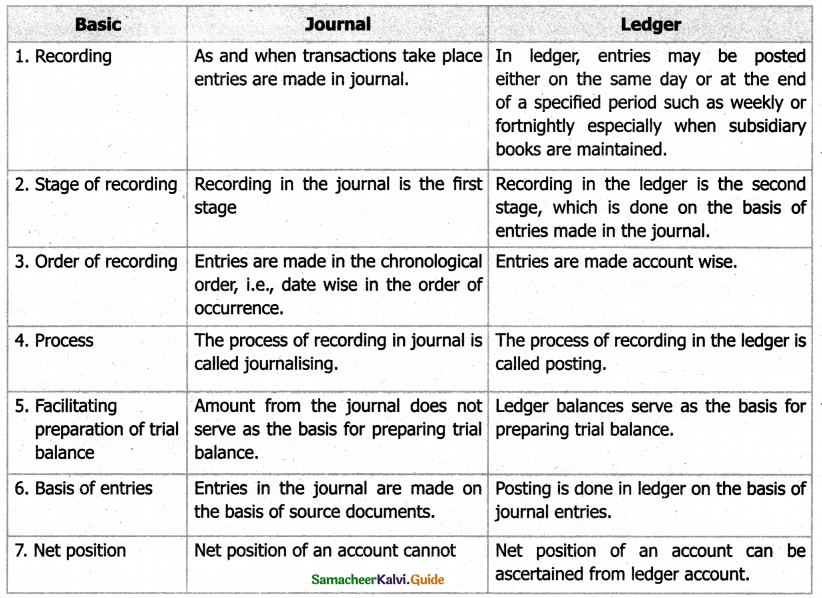
![]()
Question 2.
What is ledger? Explain its utilities.
Answer:
1. Ledger account is a summary statement of all the transactions relating to a person, asset, liability, expense or income which has taken place during a given period of time and it shows their net effect.
2. It is a book which contains all sets of accounts, namely, personal, real and nominal accounts.
3. Account wise balance can be determined from the ledger.
4. The ledger accounts are prepared based on journal entries passed.
Quick information about a particular account:
Ledger account helps to get all information about a particular account like sales, purchases, machinery, etc., at a glance.
For example, where there are several transactions with a debtor, the net amount due from a debtor can be known from the ledger account.
Control over business transactions:
From the ledger balances extracted, a thorough analysis of account balances can be made which helps to have control over the business transactions.
Trial balance can be prepared:
With the balances of ledger accounts, trial balance can be prepared to check the arithmetical accuracy of entries made in the journal and ledger.
Helps to prepare financial statements:
From the ledger balances extracted, financial statements can be prepared for ascertaining net profit or loss and the financial position.
Question 3.
How is posting made from, the journal to the ledger?
Answer:
The process of transferring the debit and credit items from the journal to the ledger accounts is called posting. The procedure of posting from journal to ledger is as follows:
1. Locate the ledger account that is debited in the journal entry. Open the respective account in the ledger, if already not opened. Write the name of the account in the top middle. If already opened, locate the account from the ledger index. Now entries are to be made on the debit side of the account.
2. Record the date of the transaction in the date column on the debit side of that account.
3. Record the name of the account credited in the journal with the prefix ‘To’ in particulars column.
4. Record the amount of the debit in the ‘amount column’.
5. Locate the ledger account that is credited in the journal entry. Open the respective account in the ledger, if already not opened. Write the name of the account in the top middle. If already opened, locate the account from the ledger index. Now entries are to be made on the credit side of the account. Record the date of the transaction in the date column. Record the name of the account debited in the journal entry in the particulars column with the prefix ‘By’ and write the amount in the amount column.
Question 4.
Explain the procedure for balancing a ledger account.
Answer:
1. The debit and credit columns of an account are to be totalled separately.
2. The difference between the two totals is to be ascertained.
3. The difference is to be placed in the amount column of the side having lesser total. ‘Balance c/d’ is to be entered in the particulars column against the difference and in the date column the last day of the accounting period is entered.
4. Now both the debit and credit columns are to be totalled and the totals will be equal. The totals of both sides are to be recorded in the same line horizontally. The total is to be distinguished from other figures by drawing lines above and below the amount.
5. The difference has to be brought down to the opposite side below the total. ‘Balance b/d’ is to be entered in the particulars column against the difference brought down and in the date column, the first day of the next accounting period is entered.
6. If the total on the debit side of an account is higher, the balancing figure is debit balance and if the credit side of an account has higher total, the balancing figure is credit balance. If the two sides are equal, that account will show nil balance.
IV. Exercises
Question 1.
Journalise the following transactions and post them to ledger.
2016 Jan.1 Started business with cash – 10,000
5 Paid into bank – 5,000
7 Purchased goods from Ram for cash – 1,000
Answer:
Journal of Mr. X
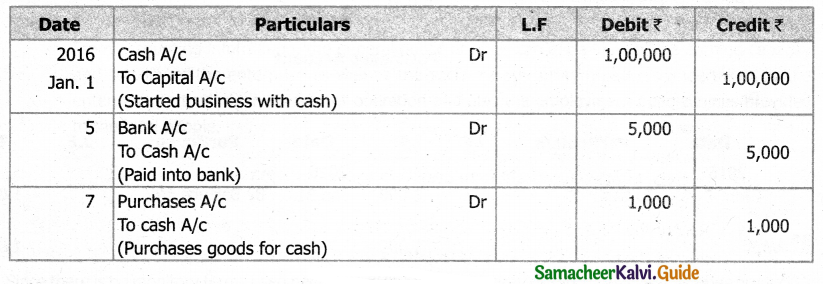
Ledger Account
Cash Account
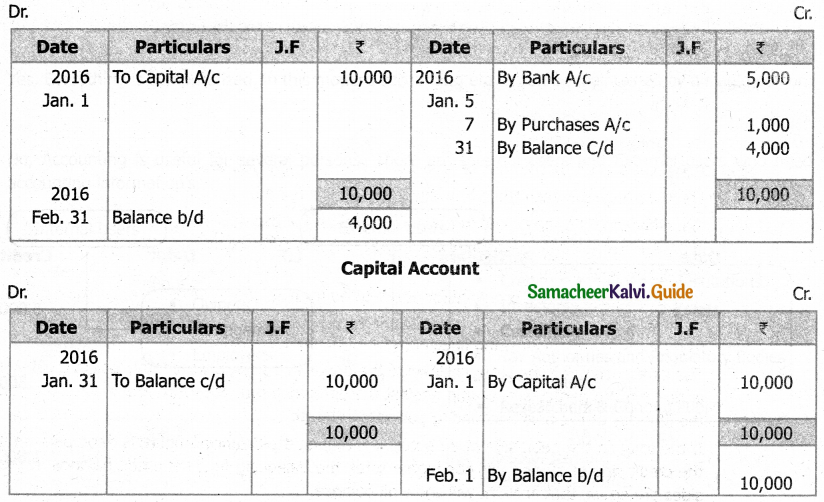
Bank Account
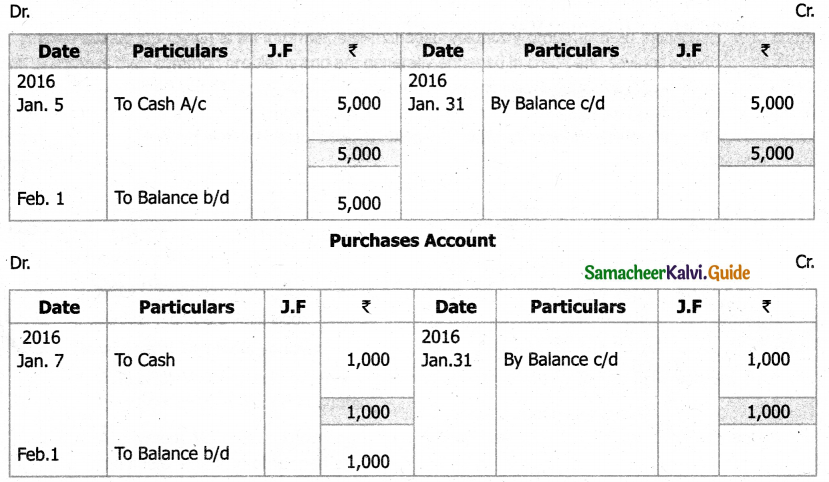
Question 2.
Give journal entries for the following transactions and post them to ledger.
2015, March 1 Goods sold to Somu on credit – 5,000
7 Furniture purchased for cash – 300
15 Interest received – 1,800
Answer:
Journal of Mr.Y
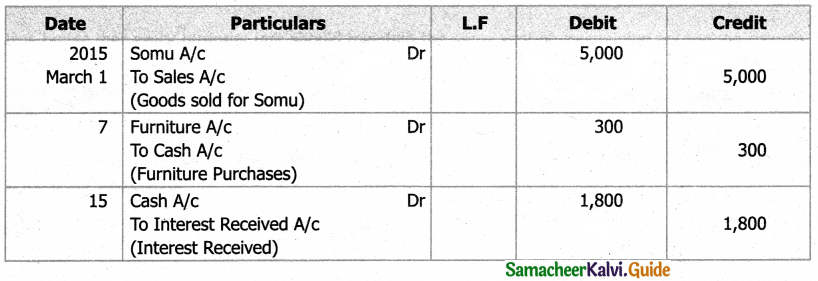
Ledger Account
Samu Account
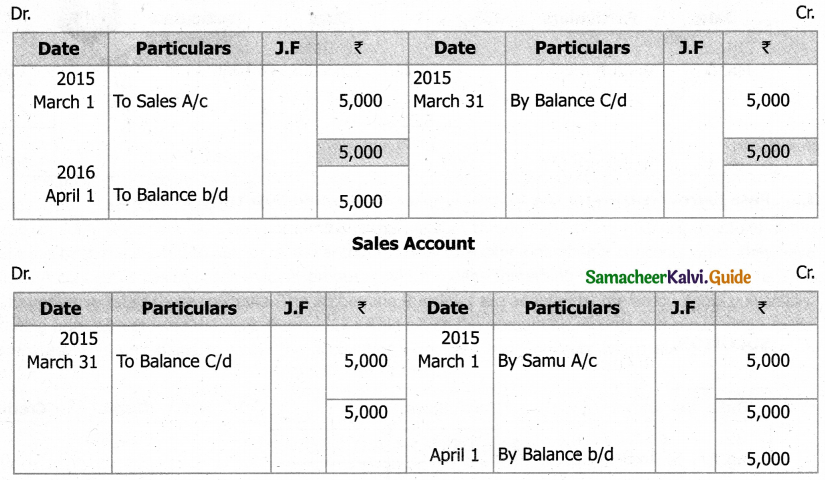
Furniture Account
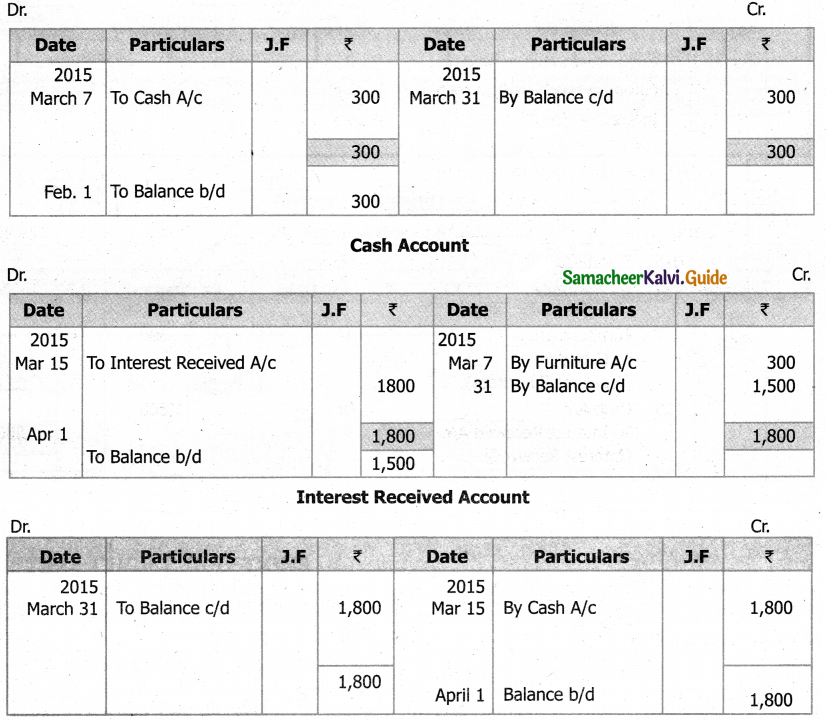
![]()
Question 3.
Pass journal entries for the following transactions and post them to ledger.
2017 Aug 1 Dharma started business with cash – 70,000
6 Cash received from Ganesan – 10,000
10 Rent paid – 3000
20 Received commission from Anand – 5000
Answer:
Journal of Mr. Dharma
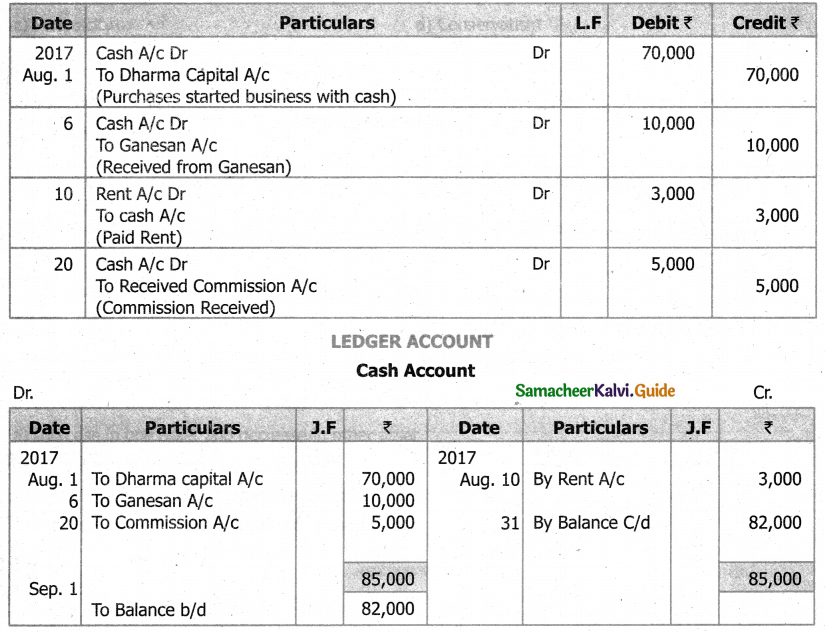
Dharma Capital Account
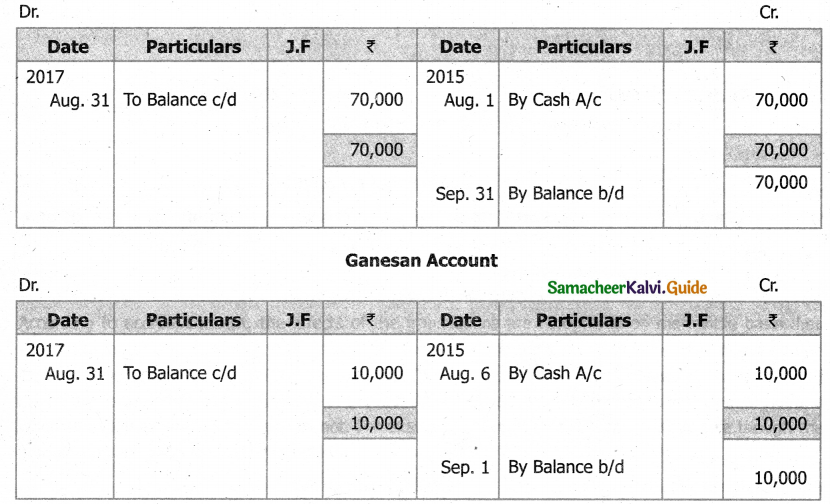
Rent Account
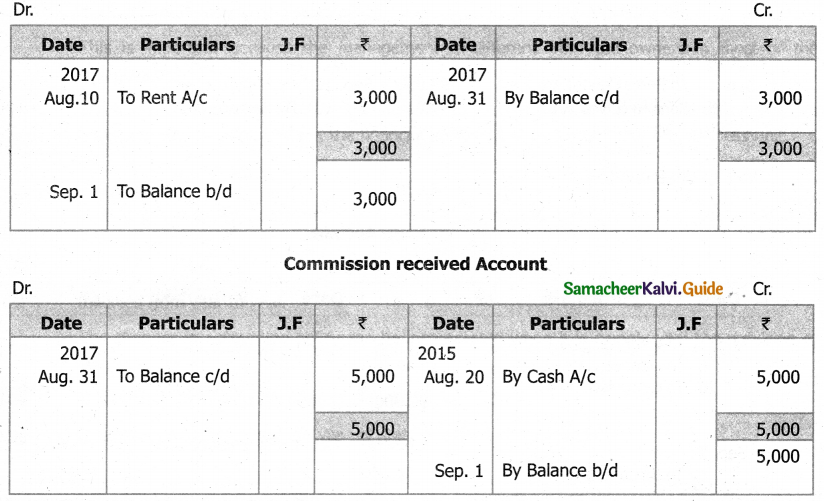
Question 4.
Record the following transactions in the journal of Banu and post them to the ledger.
2018, Sep 1 Commenced business with cash – 90,000
5 Rent received – 4,000
12 Purchased 6 tables from Gobu & Co. for cash – 6,000
Answer:
Journal of Mr. Banu
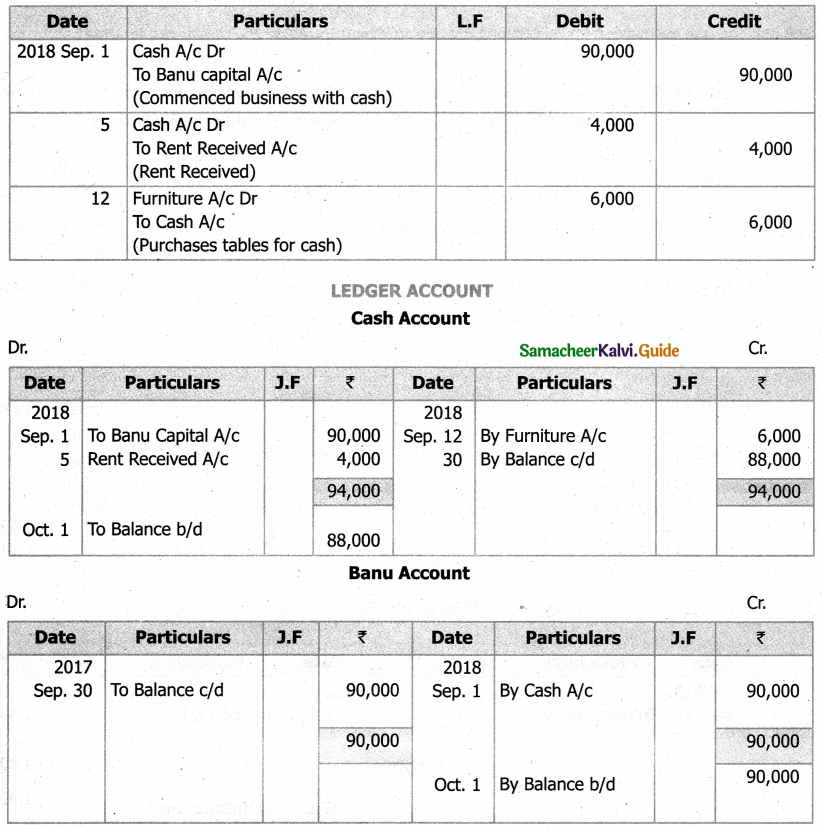
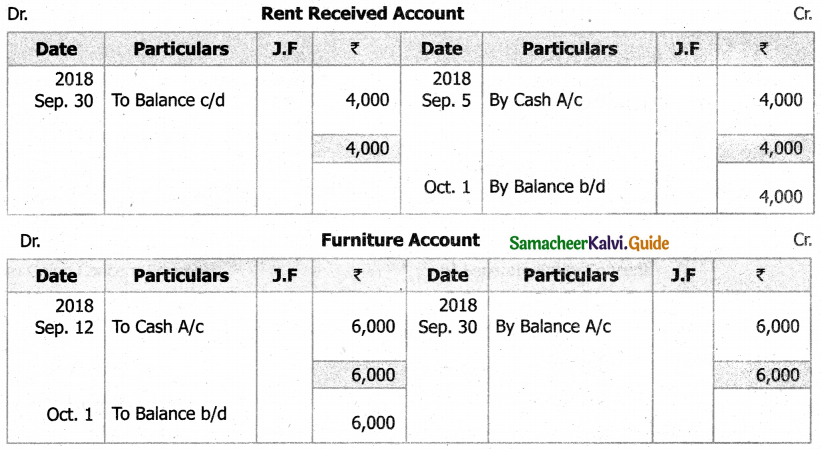
Question 5.
The following balances appeared in the books of Vinoth on Jan 1, 2018.
Assets: Cash Rs 40,000; Stock Rs 50,000; Amount due from Ram Rs 20,000
Machinery Rs 40,000 Liabilities: Amount due to Vijay Rs 10,000
Pass the opening journal entry and post them to Vinoth’s Capital account,
Answer:
Opening Entry
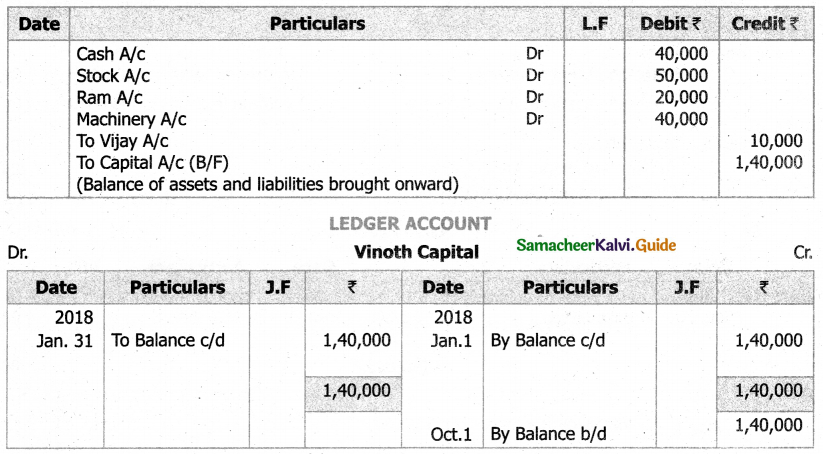
Question 6.
Prepare Furniture A/c from the following transactions
2016, Jan 1 Furniture in hand – 2,000
1 Purchased furniture for cash – 4,000
30 Sold furniture – 400
Answer:
Furniture Account
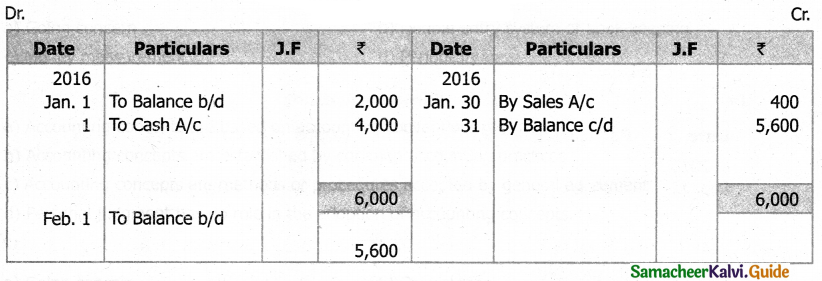
Question 7.
The following balances appeared in the books of Kumaran on April 1, 2017.
Assets: Cash Rs 1,00,000; Stock Rs 40,000; Amount due from Rohit Rs 10,000;
Furniture Rs 10,000;
Liabilities: Amount due to Anusha Rs 40,000;
Kumaran’s capital Rs 1,20,000
Find the capital and show the ledger posting for the above opening balances.
Answer:
Opening Entry
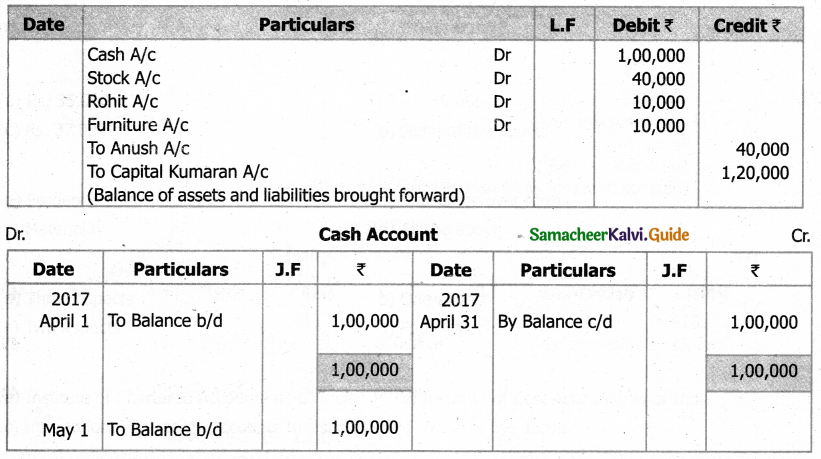
Stock Account
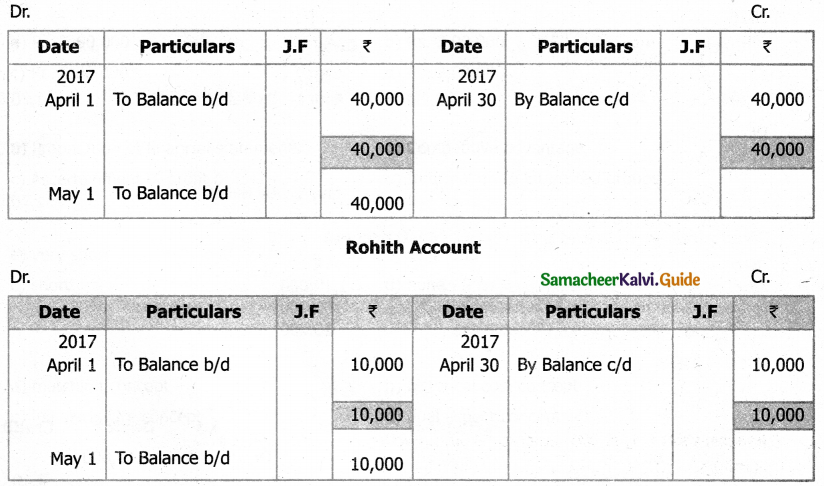
Furniture Account
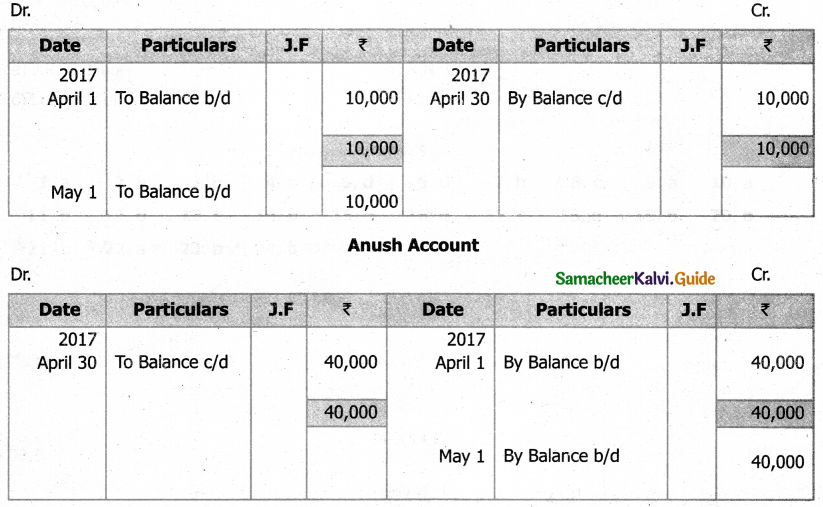
Kumaran Account

Question 8.
Give journal entries and post them to cash account.
2016, June 1 Commenced business with cash – 1,10,000
10 Introduced additional capital – 50,000
28 Withdrawn for personal use – 20,000
Answer:
Journal Entry
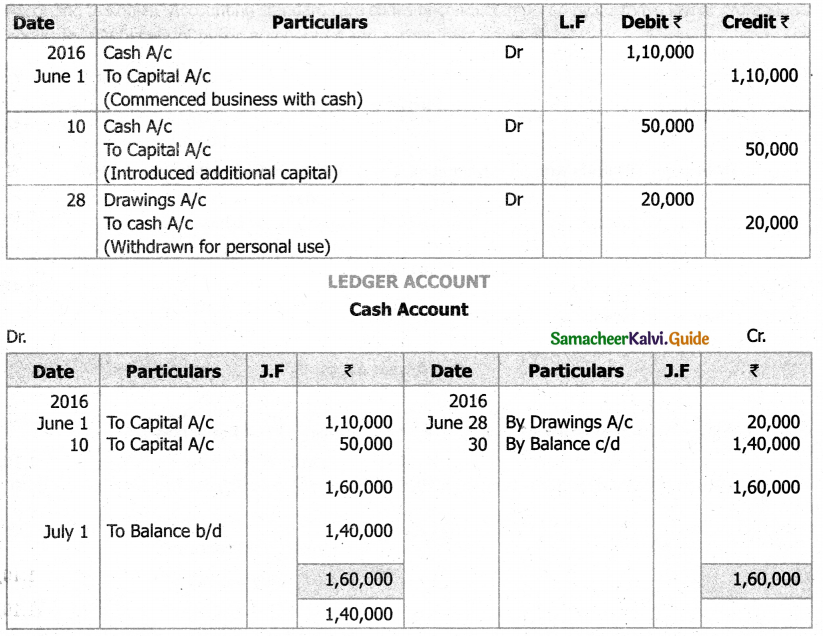
Question 9.
Give journal entries from the following transactions of Mohit, dealing in Textiles and post them to ledger.
2014 Aug 1 Commenced business with cash – 1,10,000
7 Opened bank account with SBI – 50,000
3 Purchased furniture for cash – 20,000
Answer:
Journal of Mohit
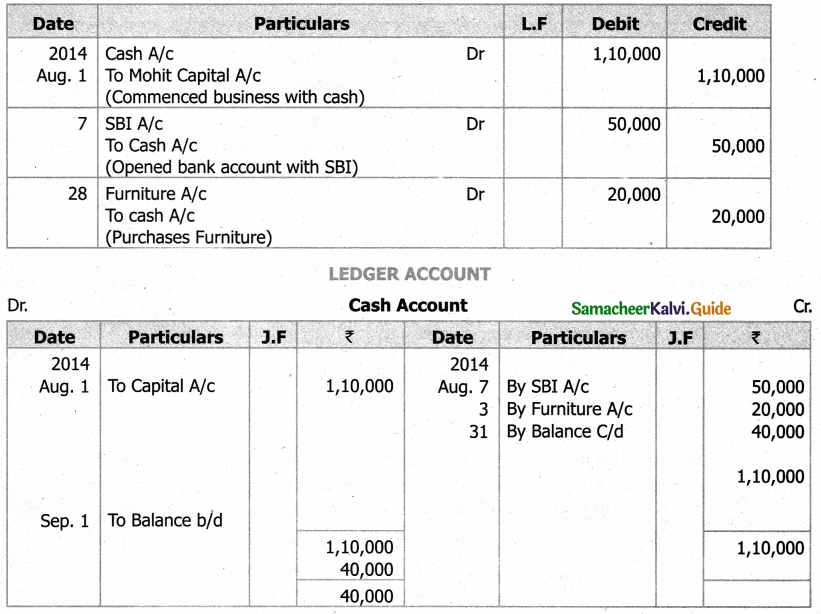

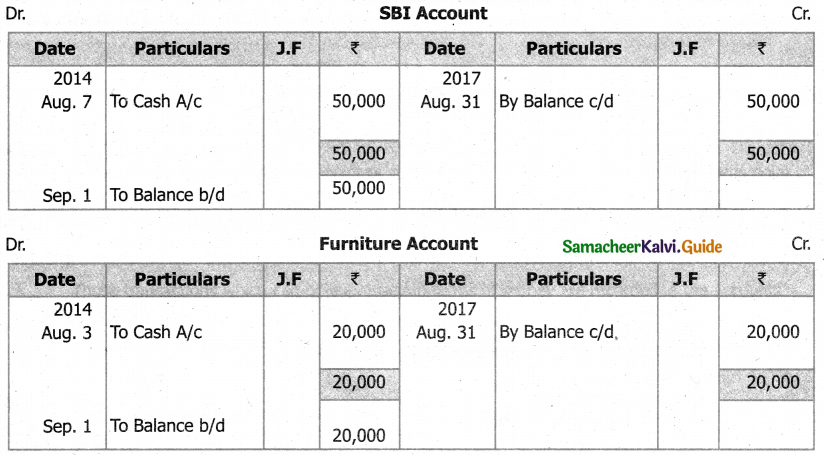
Question 10.
Give journal entries for the following transactions and post them to ledger.
2016, sep 1 Commenced business with cash – 80,000
7 Bought goods for cash from Roopan – 10,000
10 Purchased goods from Hema on credit – 42,000
22 Goods returned to Hema – 2,000
23 Cash paid to Hema – 10,000
Answer:
Journal of Entry Mr. Y
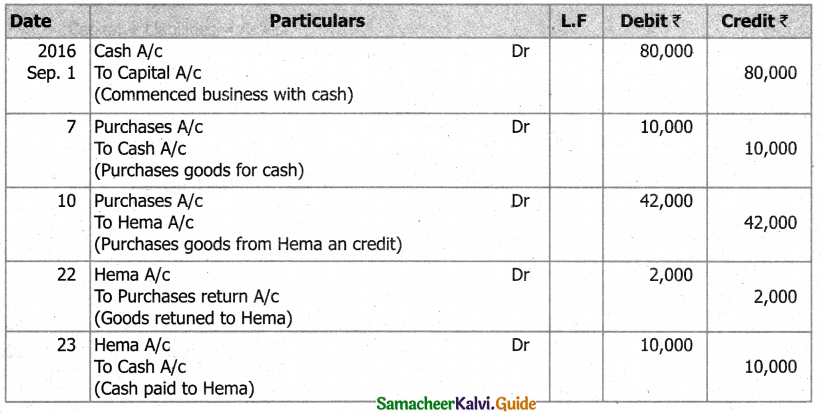
Ledger Account
Cash Account
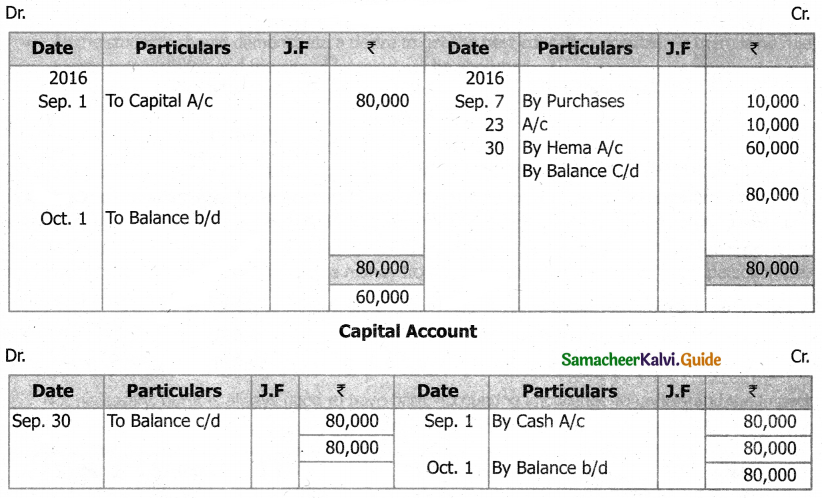
Purchases Account
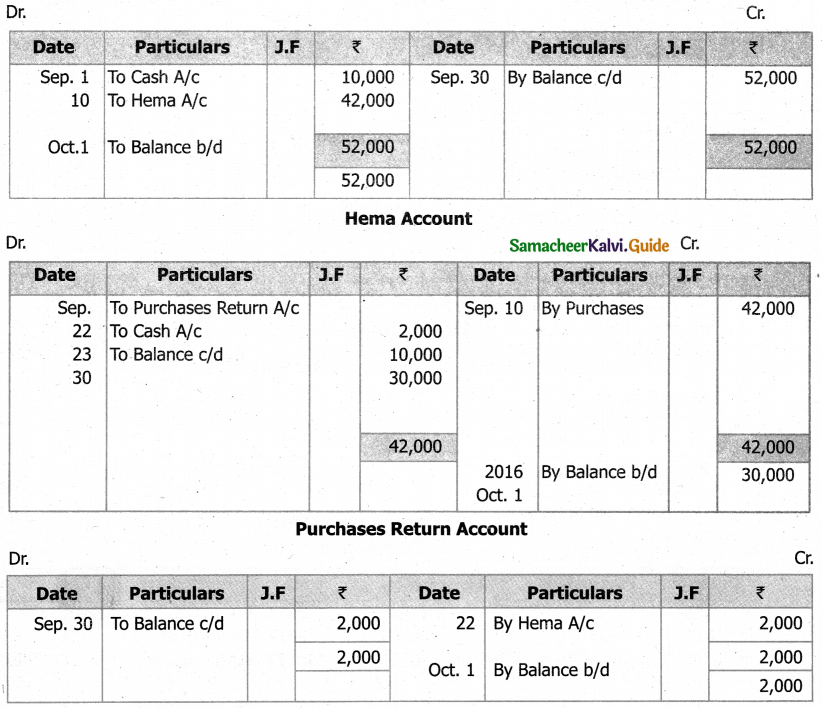
![]()
Question 11.
Give Journal entries for the following transactions and post them to Cash A/c and
Sales A/c.
2017, Aug 10 Sold goods and cheque received but not deposited – 30,000
14 Sold goods on credit to Gopi – 12,000
20 Received cash from Gopi – 12,000
Answer:
Journal of Entry Mr. Y
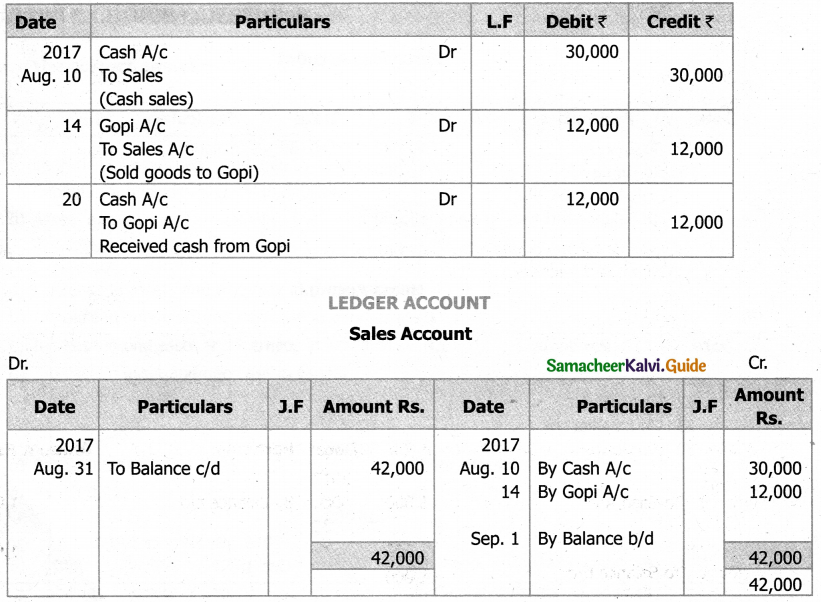
Cash Account

Question 12.
Journalise the transactions given below and post them to ledger.
2017 Oct. 18 Paid trade expenses – 1,000
25 Bought postage stamps – 100
30 Commission received – 6,000
30 Rent paid – 4,000
Answer:
Journal of Entries
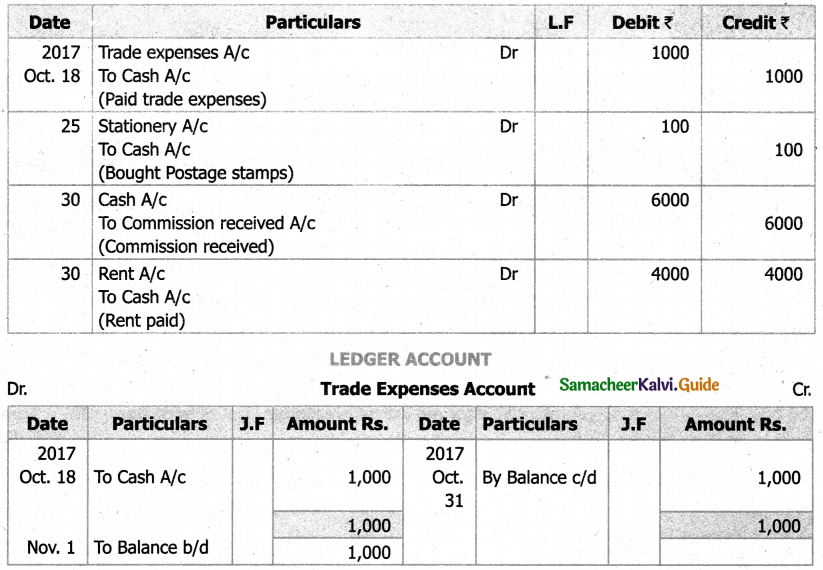
Cash Account
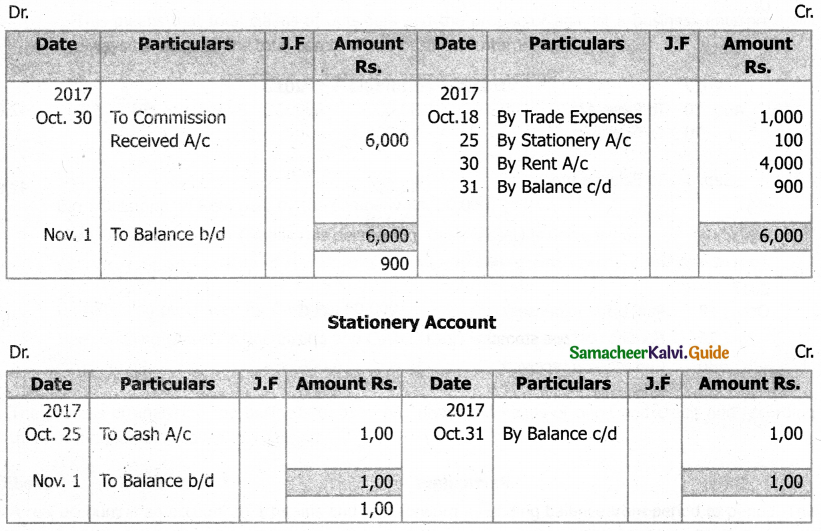
Commission Received Account
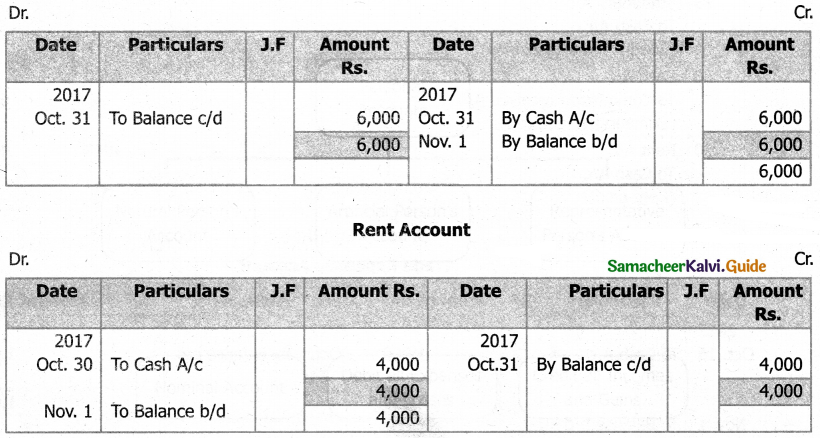
Question 13.
Journalise the following transactions and prepare ledger accounts.
2015, Feb 1 Sold goods for cash – 5,000
2 Purchased goods from Kumar on credit – 4,000
5 Sold goods to Prabu on credit – 8,000
12 Received cash from Prabu – 1,200
20 Paid to Kumar – 2,000
25 Paid salary – 3,000
Answer:
Journal Entry
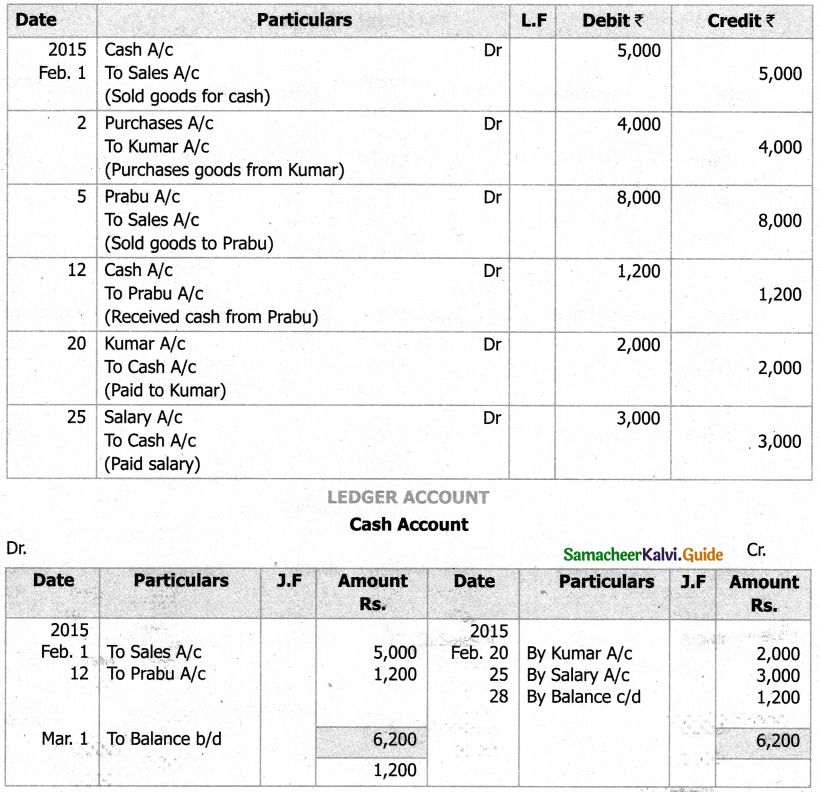
Sales Account
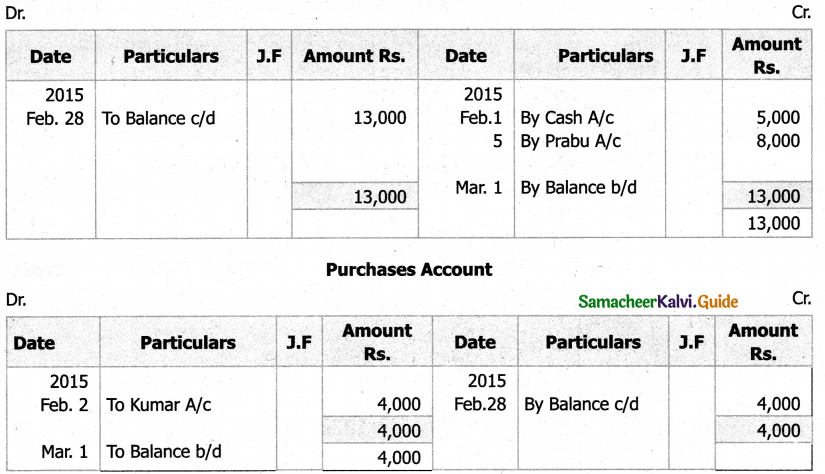
Prabhu Account
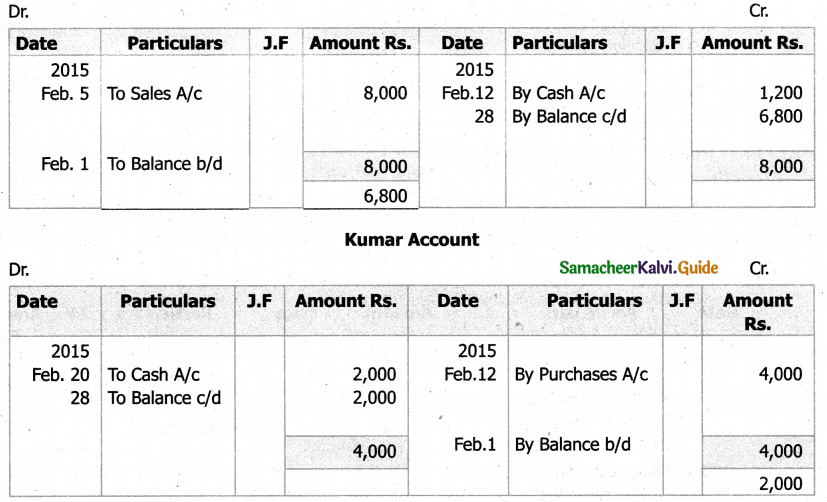

Question 14.
Enter the following transactions in the books of Ganesan and post them into ledger.
2017, Oct 1 Started business with cash – 25,000
5 Deposited into bank – 12,500
10 Purchased furniture and payment by cheque – 2,000
15 Goods purchased for cash – 5,000
19 Sold goods to Vasu on credit – 4,000
22 Goods worth Rs 500 taken for personal use
Answer:
Journal of Ganesan
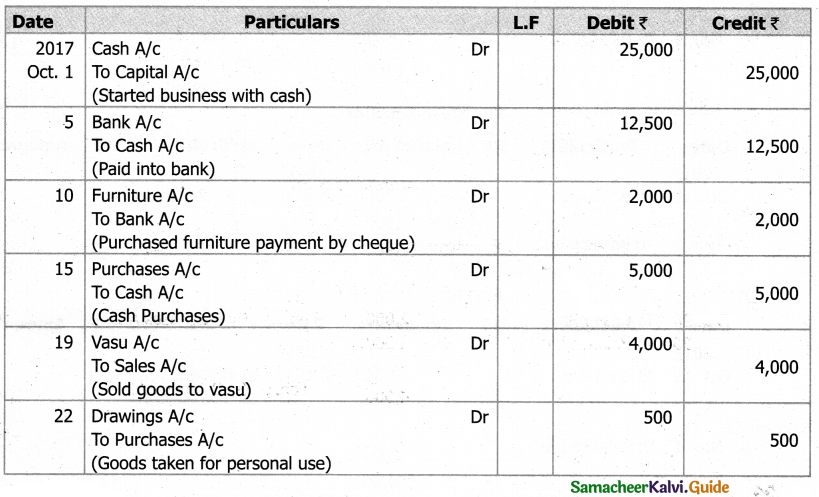
Ledger Account
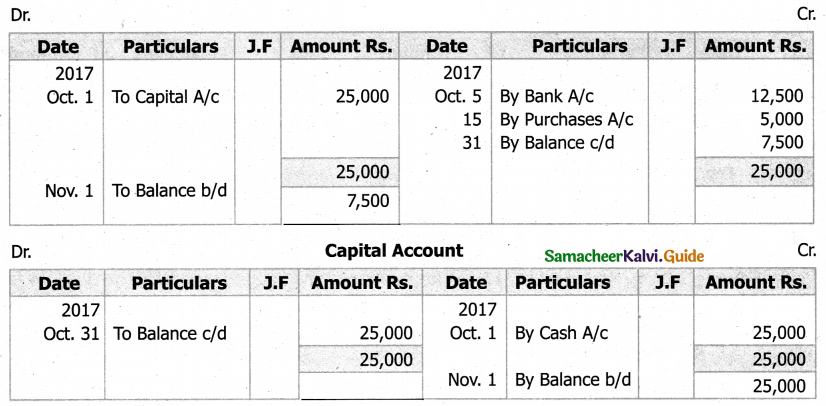
Bank Account
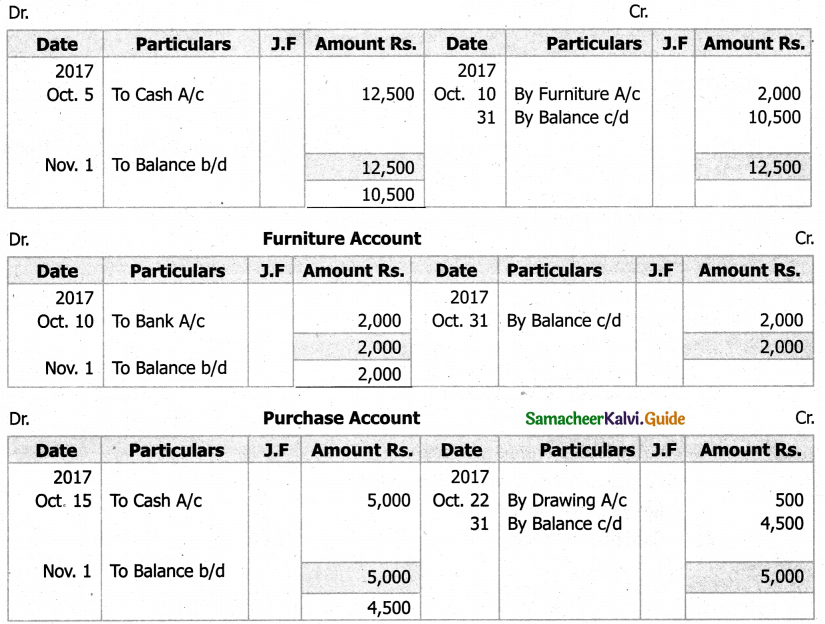
Vasu Account
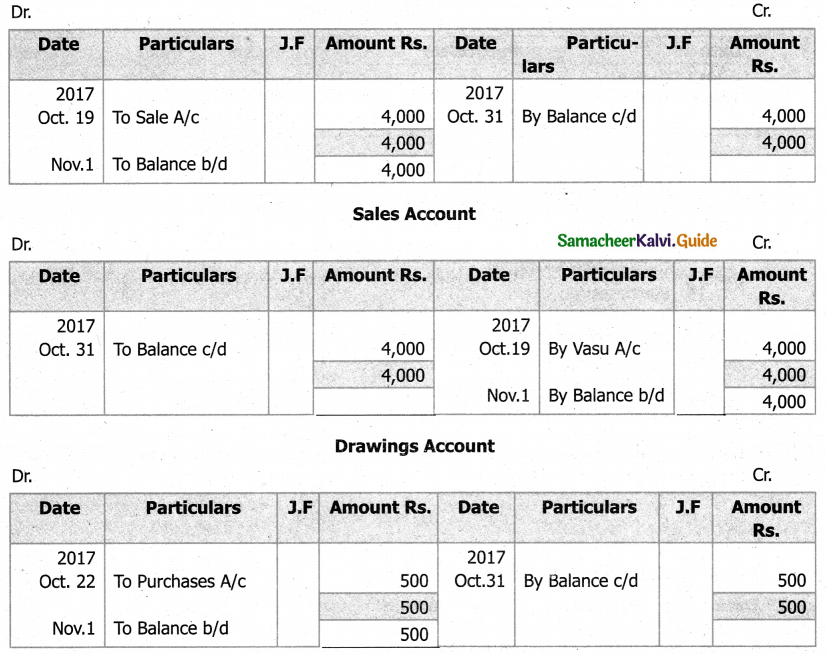
Question 15.
Journalise the following transactions in the books of Arun and post them to ledger accounts
accounts.
2017, Dec 1 Arun started his business with cash – 10,000
3 Bought goods for cash – 1,500
8 Sold goods to Krishna on credit – 4,000
14 Purchased goods from Govind on credit – 2,000
25 Received cash from Krishna – 3,000
28 Cash paid to Govind – 1,000
Answer:
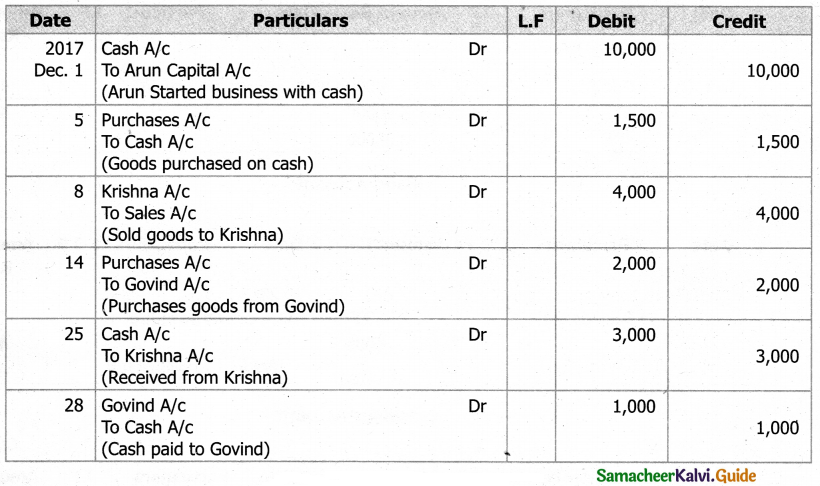
Ledger Account
Cash Account
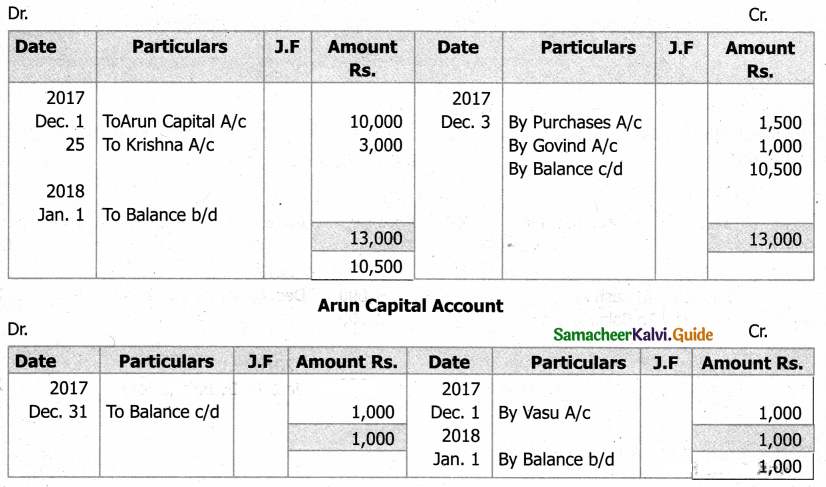
Purchases Account
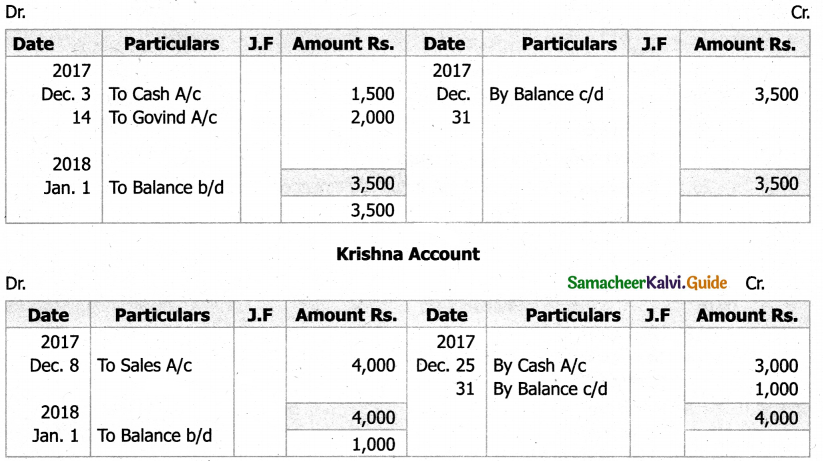
Sales Account
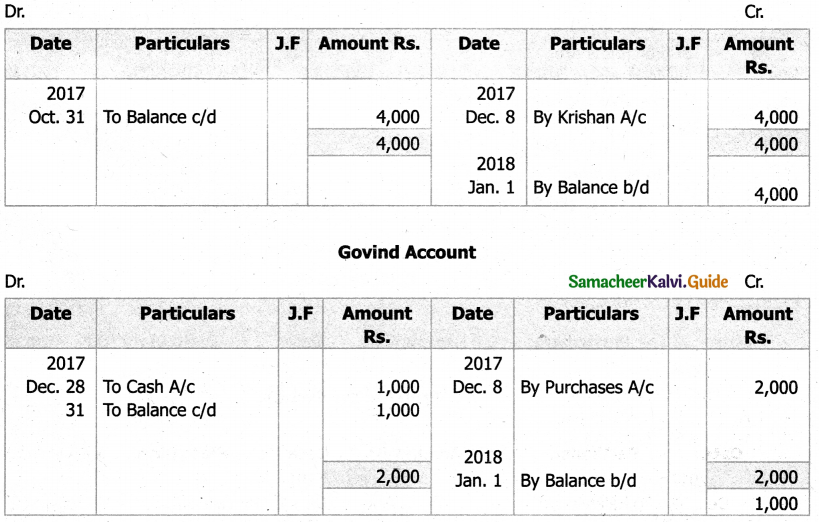
Question 16.
Journalise the following transactions and post them to ledger in the books of Raja.
2018, Mar 1 Sold goods to Senthil for cash – 9,000
5 Sold goods to Murali on credit – ,500
9 Cash sales – 6,000
18 Bought goods from Mani on credit – 3,200
23 Received Rs 4,000 from Murali in full settlement of his account
Answer:
Journal of Raja
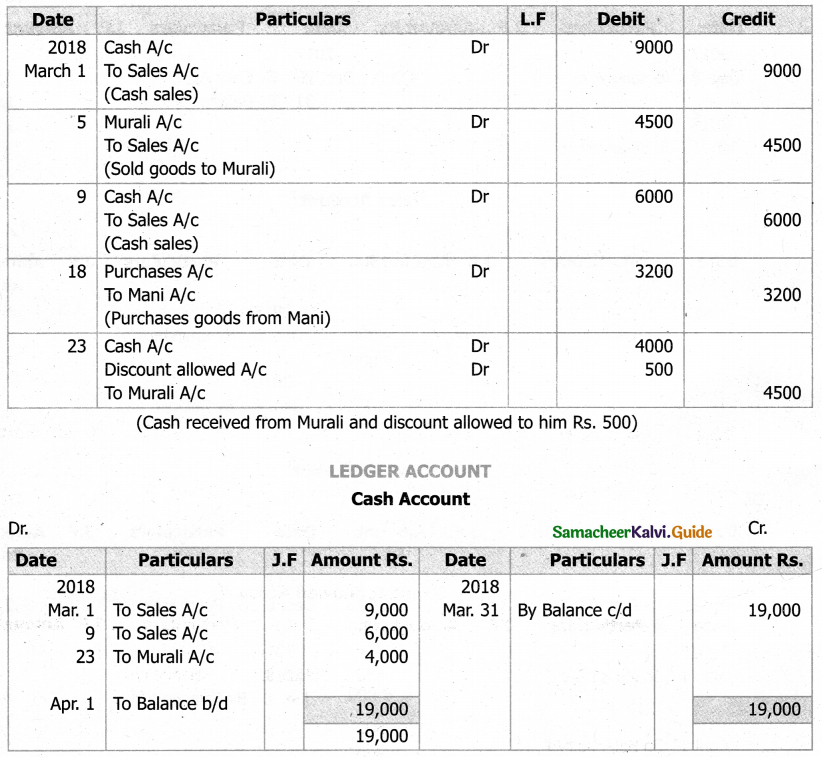
Sales Account
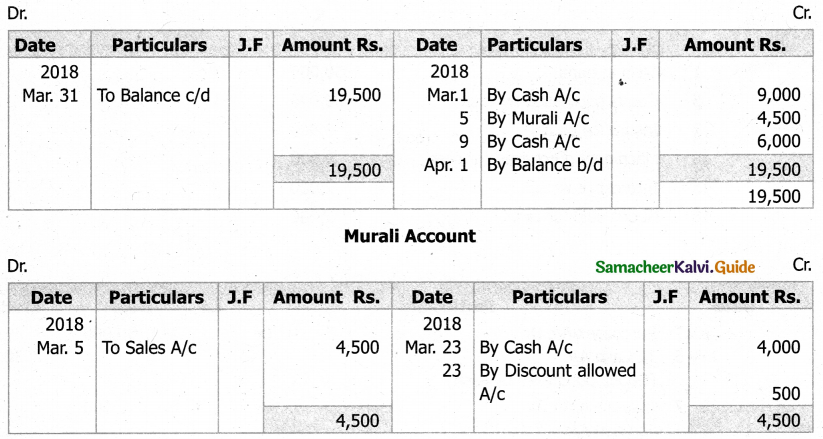
Purchases Account
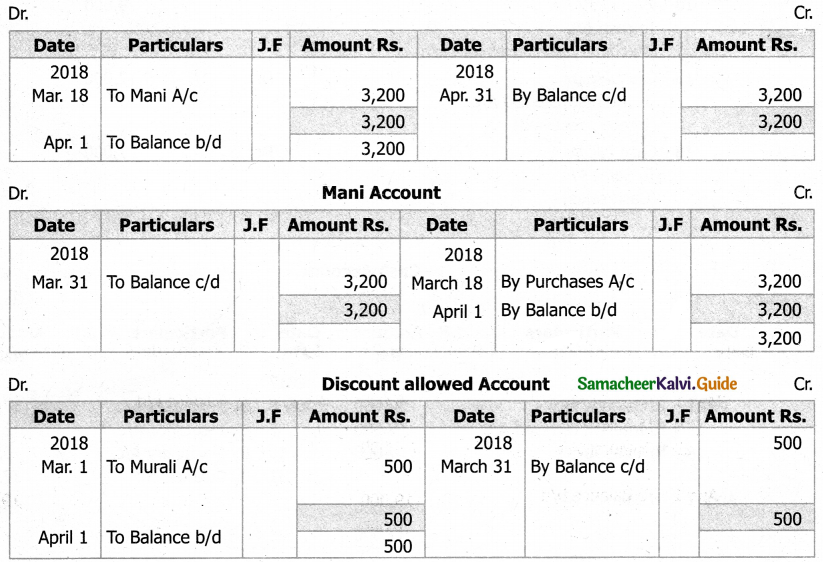
![]()
Question 17.
Journalise the following transactions and post them to the ledger.
2017, July 1 Cash in hand – 50,000
5 Goods purchased by cash – 30,000
7 Insurance paid – 2,500
10 Machinery purchased for cash – 9,000
15 Interest received – 2,000
18 Goods sold for cash – 7,000
Answer:
Journal of Entry of Mr. Y
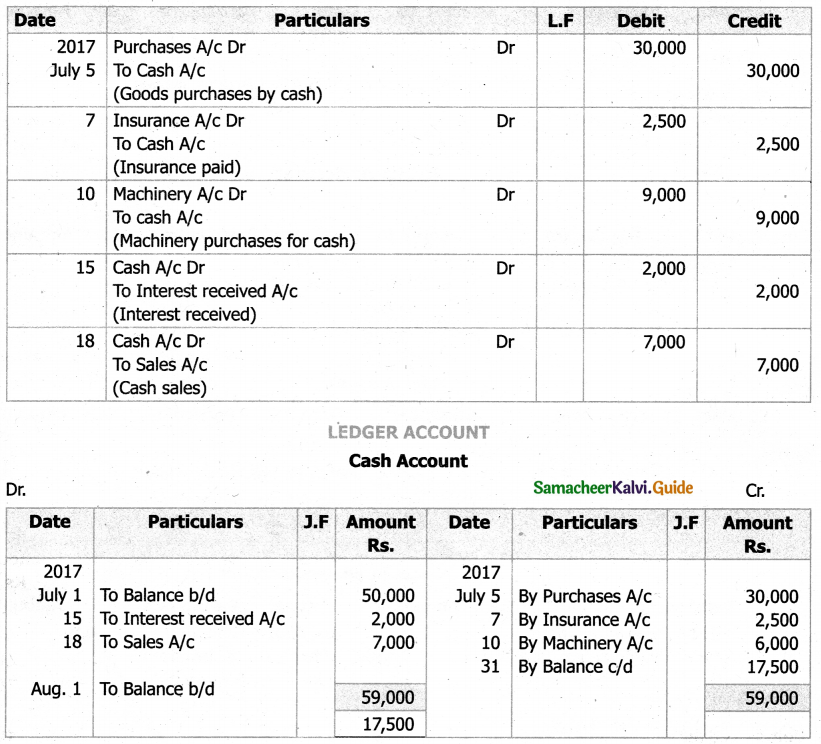
Purchases Account
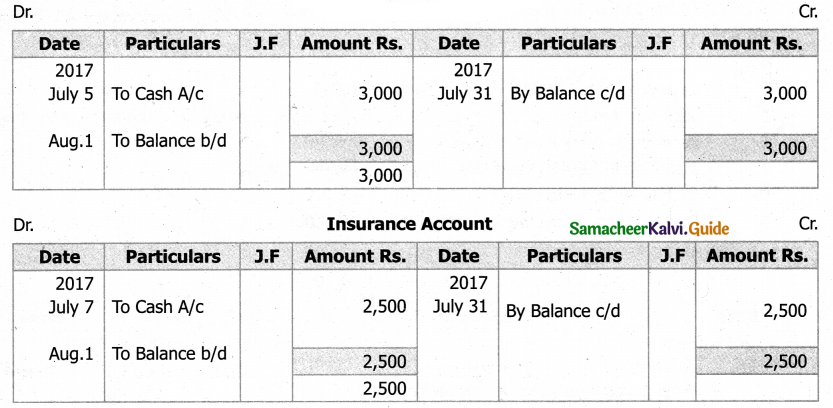
Machinary Account
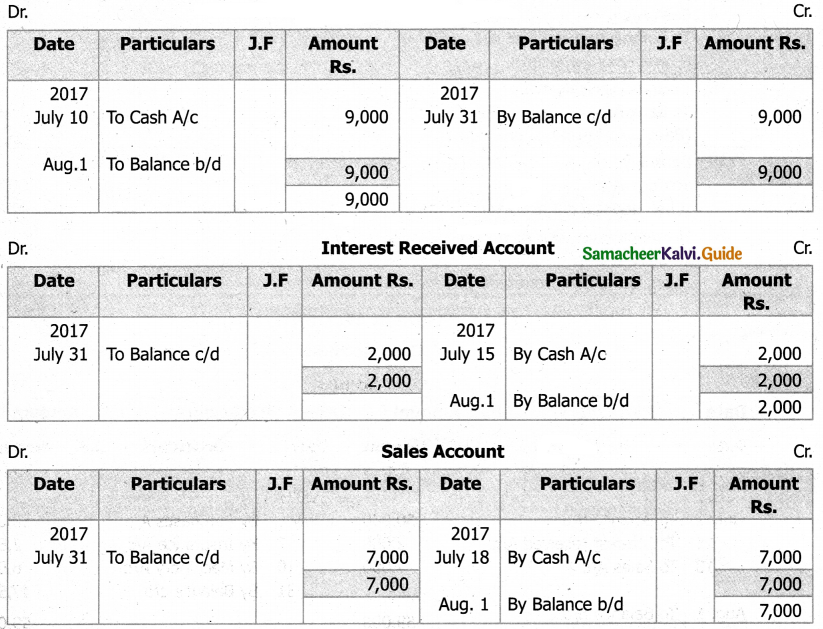
Question 18.
Journalise the following transactions in the books of Vasu and post them to ledger accounts.
2017, Nov 1 Cash in hand Rs 1,00,000; Cash at bank: Rs 30,000
2 Vasu sold goods to Jothi for Rs 25,000 against a cheque and deposited the same in the bank
4 Received as commission Rs 5,000
8 Bank paid Rs 15,000 directly for insurance premium of Vasu.
15 Cash deposited into bank Rs 30,000
20 Cash withdrawn from bank for personal use Rs 45,000.
Answer:
Journal of Mr. Vasu
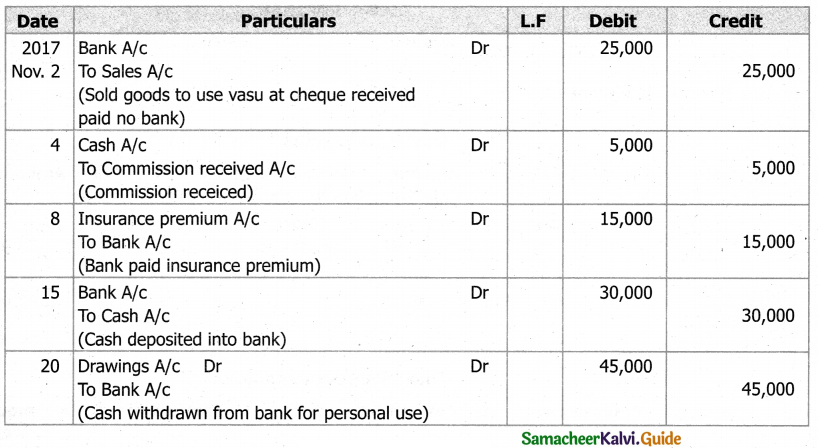
Ledger Account
Cash Account
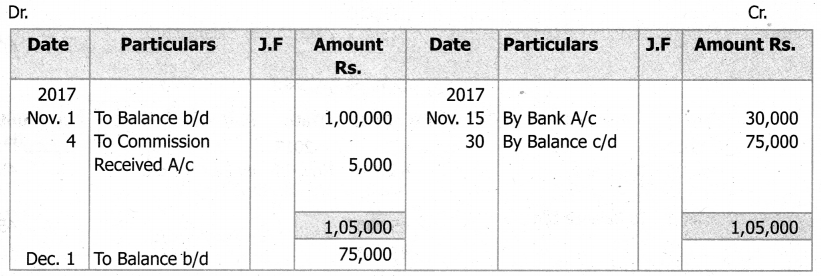
Bank Account
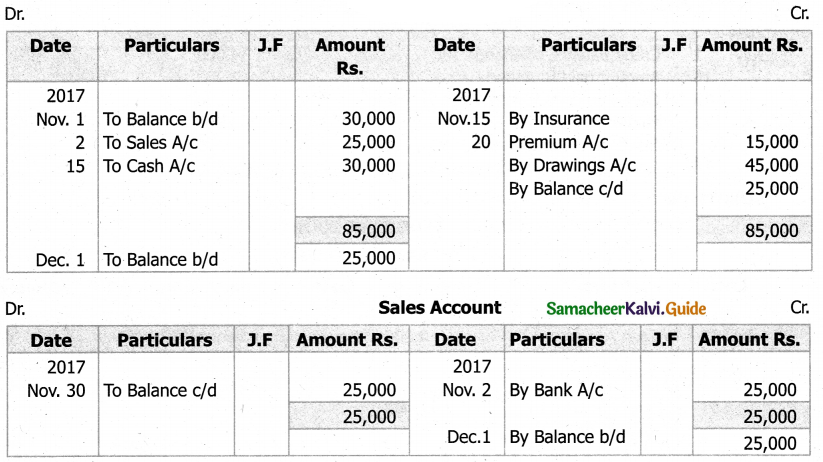
Commission Received Account
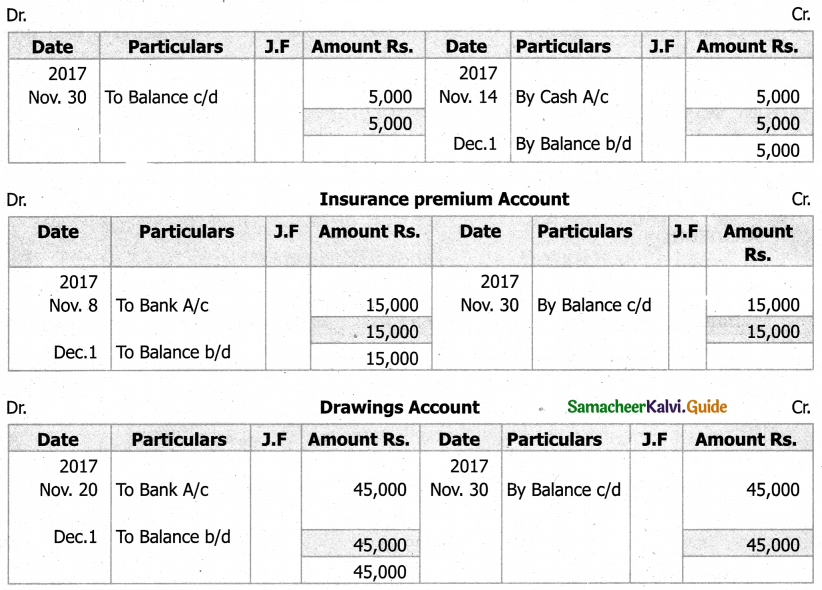
Question 19.
Prepare Anand’s account from the following details.
2017, July 1 Credit balance of Anand’s A/c – 4,000
15 Amount paid to Anand – 2,000
18 Goods purchased from Anand on credit – 8,000
20 Paid to Anand – 3,960
Discount allowed by him – 40
25 Goods purchased from Anand – 5,000
Answer:
Ledger Account
Dr. Anand’s Account
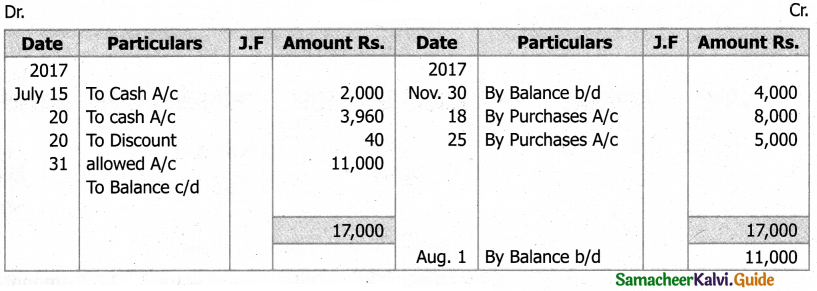
Question 20.
Prepare a Sales account from the following transactions.
2018, Jan 1 Sold goods to Sam – 4,000
4 Sold goods to Suresh – 2,500
11 Sold goods to Joy – 8,000
17 Sold goods to Rajan – 3,000
Answer:
Ledger Account
Sales Account
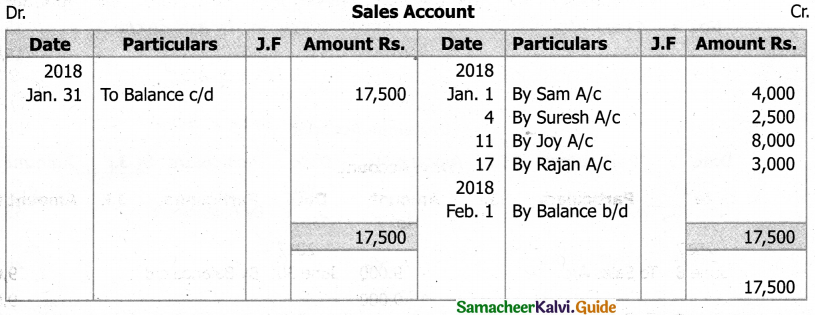
![]()
Question 21.
Show the direct ledger postings for the following transactions:
2017, June 1 Raja commenced business with cash Rs 50,000,
6 Sold goods for cash Rs 8,000
8 Sold goods to Devi on credit Rs 9,000
15 Goods purchased for cash Rs 4,000
20 Goods purchased from Shanthi on credit Rs 5,000
Answer:
Ledger Account
Cash Account
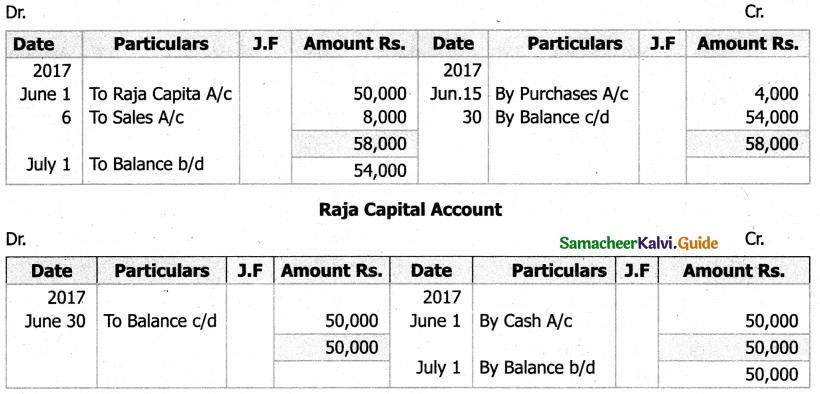
Sales Account
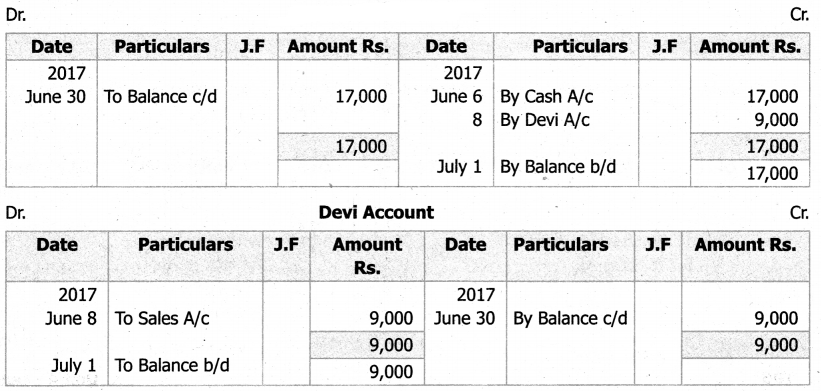
Purchases Account
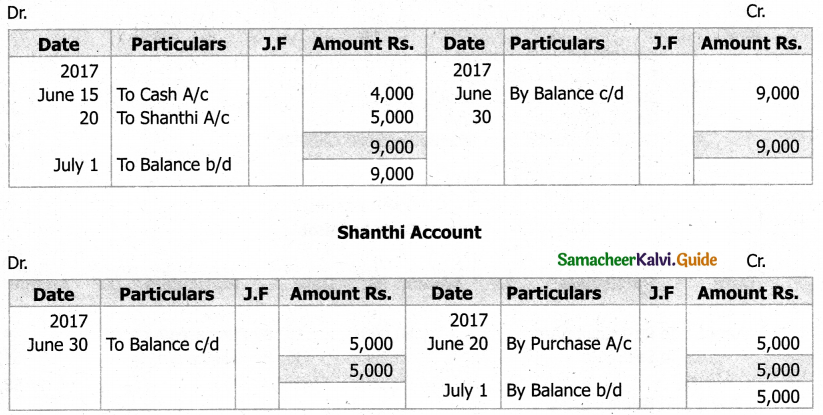
Question 22.
Show the direct ledger postings for the following transactions:
2017, July 1 Shankar commenced business with a cash of Rs 1,00,000
5 Sold goods for cash Rs 10,000
9 Wages paid Rs 6,000
19 Salaries paid Rs 8,000
20 Advertisement expenses paid Rs 4,000
Answer:
Ledger Account
Cash Account

Shankar Capital Account
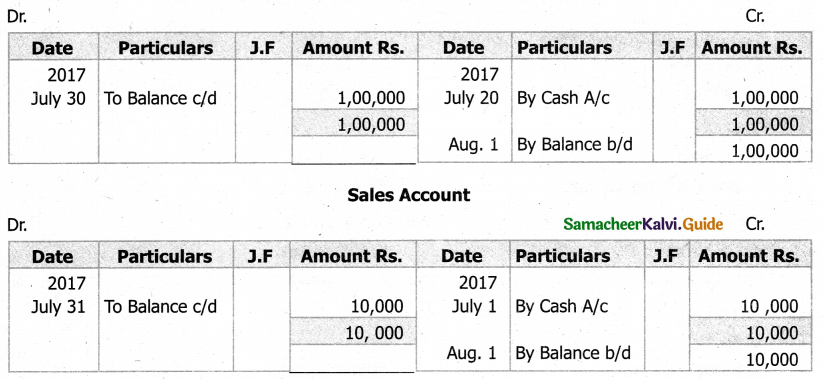
wages Account
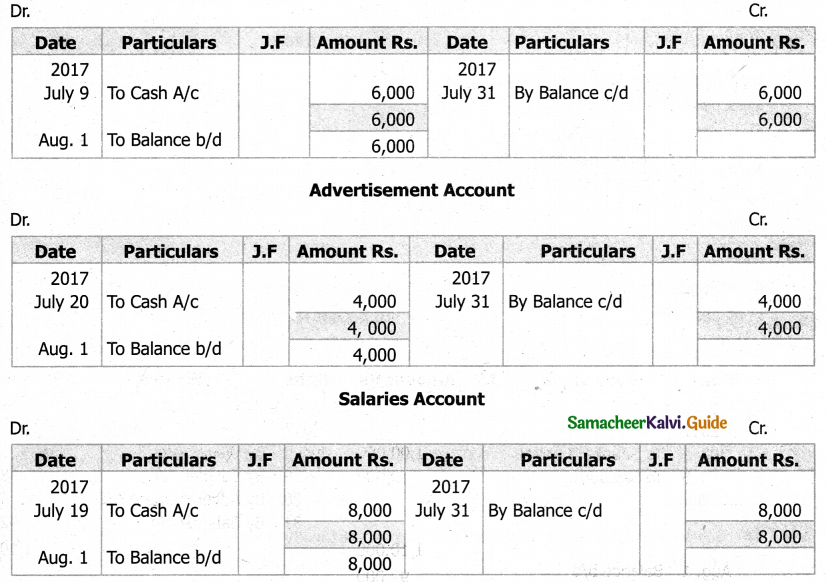
11th Accountancy Guide Ledger Additional Important Questions and Answers
I. Choose the correct answer.
Question 1.
Ledger is a book of:
(a) original entry
(b) final entry
(c) ail cash transactions
(d) contra entry
Answer:
(b) final entry
Question 2.
Personal and real accounts are:
(a) closed
(b) Balanced
(c) closed and transferred
(d) opening
Answer:
(b) Balanced
![]()
Question 3.
The column of ledger which links the entry with journal is
(a) L.F column
(b) J.F column
(c) Date column
(d) Particulars column
Answer:
(b) J.F column
Question 4.
Posting on the credit side of an account is written as
(a) To
(b) By
(c) Being
(d) Both (a) and (b)
Answer:
(b) By
Question 5.
Posting on the Debit side of an account is written as
(a) To
(b) By
(c) Being
(d) Both (a) and (b)
Answer:
(a) To
Question 6.
Nominal account having credit balance represents
(a) income / gain
(b) expenses / losses
(c) assets
(d) liabilities
Answer:
(a) income / gain
Question 7.
Nominal account having debit balance represents
(a) income / gain
(b) expenses / losses
(c) liability
(d) assets
Answer:
(b) expenses / losses
Question 8.
Real accounts always show
(a) debit balances
(b) credit balances
(c) nill balance
(d) Both (a) and (b)
Answer:
(a) debit balances
Question 9.
Account having credit balance is closed by writing
(a) To Balance b/d
(b) By Balance c/d
(c) To Balance c/d
(d) By Balance b/d
Answer:
(c) To Balance c/d
Question 10.
When the total of debits and credits are equal, it represents
(a) debit balance
(b) credit balance
(c) nil balance
(d) opening balance
Answer:
(c) nil balance
Question 11.
The balances of personal and real accounts are shown in the
(a) profit and loss account
(b) balance sheet
(c) trading account
(d) both (a) and (b)
Answer:
(b) balance sheet
![]()
Question 12.
If the total of the credit side of an account exceeds the total of its debit side, it means
(a) Credit balance
(b) Debit balance
(c) Nil balance
(d) Debit and credit balance
Answer:
(a) Credit balance
Question 13.
The closing balance is the next year’s
(a) debit balance
(b) credit balance
(c) nil balance
(d) opening balance
Answer:
(d) opening balance
Question 14.
The ledger account is prepared in format.
(a) T
(b) D
(c) C
(d) U
Answer:
(a) T
Question 15.
The process of recording business transactions in a chronological order is called ……………
(a) Recording
(b) Posting
(c) Journalizing
(d) Classifying
Answer:
(c) Journalizing
Question 16.
Which one of the following is known as the king of all books of accounts?
(a) Recording
(b) Posting
(c) Journalizing
(d) Classifying
Answer:
(c) Journalizing
Question 17.
A decrease in the provision for doubtful debts would result in
(a) Increase in liability
(b) Decrease in liability
(c) Decrease in the net profit
(d) Increase in the net profit
Answer:
(d) Increase in the net profit
Question 18.
The discount which is calculated on the list price of the goods is called .
(a) Cash discount
(b) Rebate
(c) Trade discount
(d) Discount
Answer:
(c) Trade discount
Question 19.
Merchandise stolen by someone should be debited to …………..
(a) Sales account
(b) Purchases account
(c) Loss by theft account
(d) None of the above
Answer:
(c) Loss by theft account
Question 20.
The owner of the business takes Rs.100 cash and goods costing Rs.200 for his family. The proper journal entry for this transaction is called ……………..
(a) drawing > debit; Cash > Credit; Purchases > Credit
(b) Drawing > debit; Cash > Credit; merchandise > credit
(c) Drawing > debit; Cash > credit; Sales > credit
(d) cash > debit; Purchases > debit; drawings > credit
Answer:
(a) drawing > debit; Cash > Credit; Purchases > Credit
II. Very Short Answer Type Questions
Question 1.
What is Nil balance?
Answer:
If the two sides are equal, that account will show nil balance.
Question 2.
What are the steps involved in posting the opening entry?
Answer:
Step 1:
The items debited in the opening entry are entered on the debit side of respective accounts. The words ‘To Balance b/d’ are written in the particulars column with respective amounts in the amount column, date being the first day of the accounting period.
Step 2:
The items credited in the opening entry are entered on the credit side of respective accounts. The words ‘By Balance b/d’ are written in the particulars column with respective amounts in the amount column, date being the first day of the accounting period.
![]()
Question 3.
Indicate the nature of normal balance in the following accounts.
Answer:
a. Cash – Debit balance
b. Creditors – Credit balance
c. Sales – Credit balance
d. Furniture – Debit balance
e. Commission received – Credit balance
f. Debtors – Debit balance
g. Purchases – Debit balance
h. Capital – Credit balance
i. Discount earned – Credit balance
j. Computer – Debit balance
Question 4.
Define ledger.
Answer:
According to L.C. Cropper, ‘the book which contains a classified and permanent record of all the transactions of a business is called the Ledger’.
Question 5.
What is compound journal entry?
Answer:
When a journal entry has more than one debit or more than one credit or both, it is called a compound entry.
III. Additional Sums
Question 1.
Prepare cash account A/c from the following transactions.
2018 Jan. 1 Commenced business with cash Rs 62,000
2 Good purchased for cash Rs 12,000
10 Cash sales Rs 10,000
12 Wages paid Rs 4,000
25 Furniture purchased for cash Rs 6,000
Answer:
Ledger Account
Cash Account

Question 2.
Prepare a sales A/c from the following transaction.
2018 Feb. 1 Cash sales – 5,000
4 Sold goods to Suresh – 4,000
8 Sold goods to Mohan – 8,000
12 Sold goods for cash – 3,000
Answer:
Ledger Account
Sales Account

![]()
Question 3.
Prepare Rangasamy A/c for the following transaction.
2017 Aug. 17 Goods purchased from Rangasamy Rs. 20,000
19 Goods returned to Rangasamy Rs. 5,000
31 Settles Rangasamy’s account
Answer:
Ledger Account
Rangasamy Account

Question 4.
Prepare Chitra account from the following transaction.
2018 March. 18 Sold goods to Chitra Rs. 1,26,000
24 Chitra returned goods Rs. 6,000
28 Chitra settled her account
Answer:
Chitra Account

Question 5.
Journalise the following transaction and post them to ledger in the book of Mr. Raja.
2018, Jan. 1 Started business with cash Rs 3,00,00
2 Opening bank account by deposition Rs 2,00,000
5 Purchased goods for cash Rs 10,000
15 Cash sales Rs 5,000
22 Purchased goods from X and Co. for Rs 15,000 and the payment is made through net banking
25 Sold goods for Y and Co. for Rs 30,000 and the payment is received thought NEET
Answer:
Journal of Mr. Raja
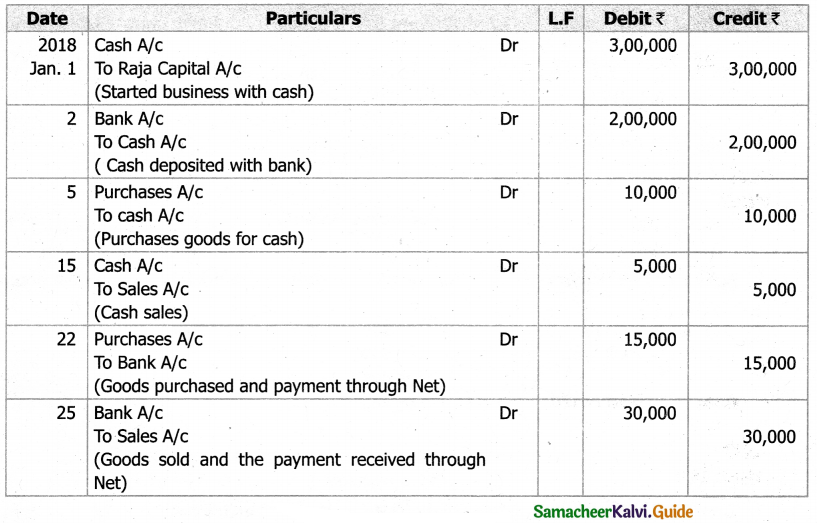
Ledger Account
Cash Account

Raja Capital Account
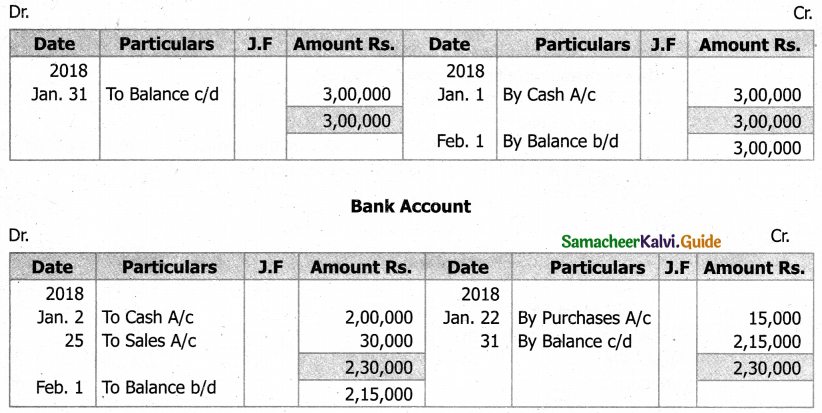
Purchases Account
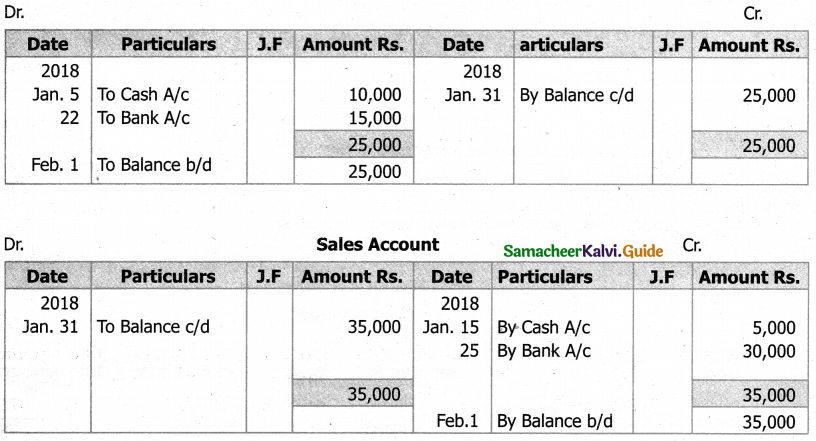
Question 6.
Post the following Journal into Ledger of Thiru. Gowri Shankar.
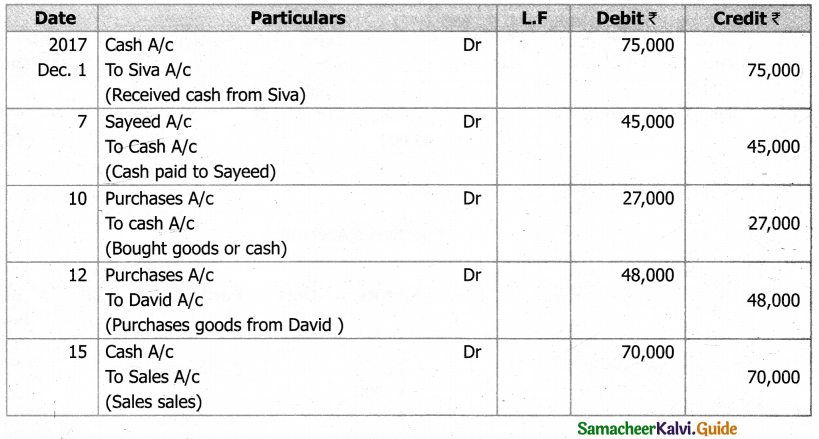
Answer:
Ledger Account
Cash Account
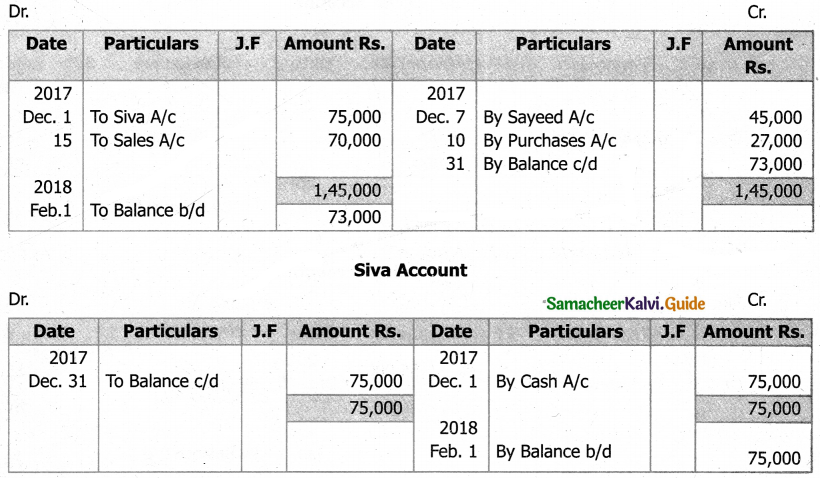
Sayeed Account
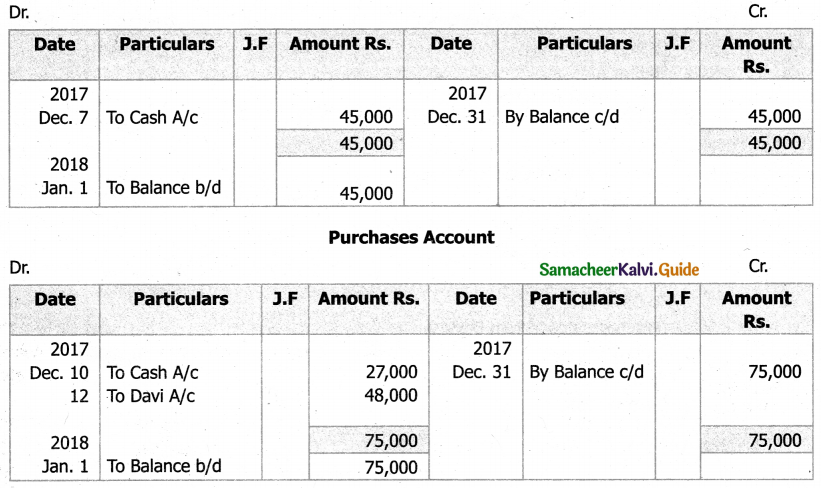
David Account
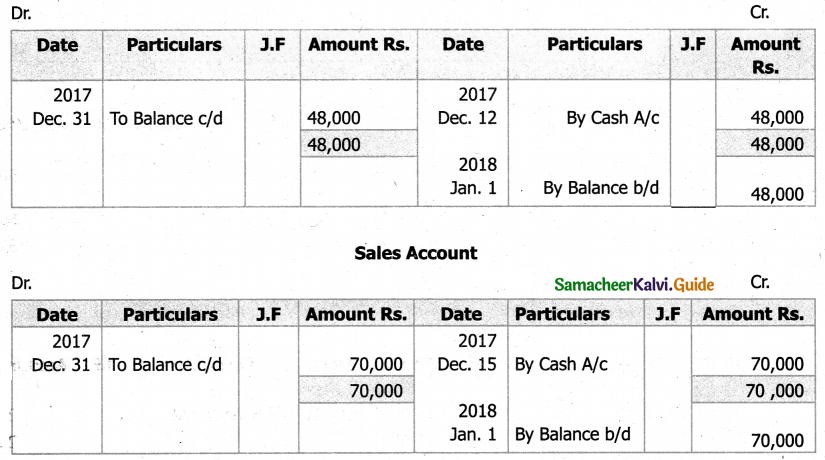
![]()
Question 7.
Show the sivect ledger positions for the following transaction.
2018, May. 1 Commenced business with cash Rs 1,50,000
2 Sold goods for cash Rs 50,000
5 Purchases goods for cash Rs 25,000
25 Salaries paid Rs 15,000
30 Wages paid Rs 10,000
Answer:
Ledger Account
Cash Account
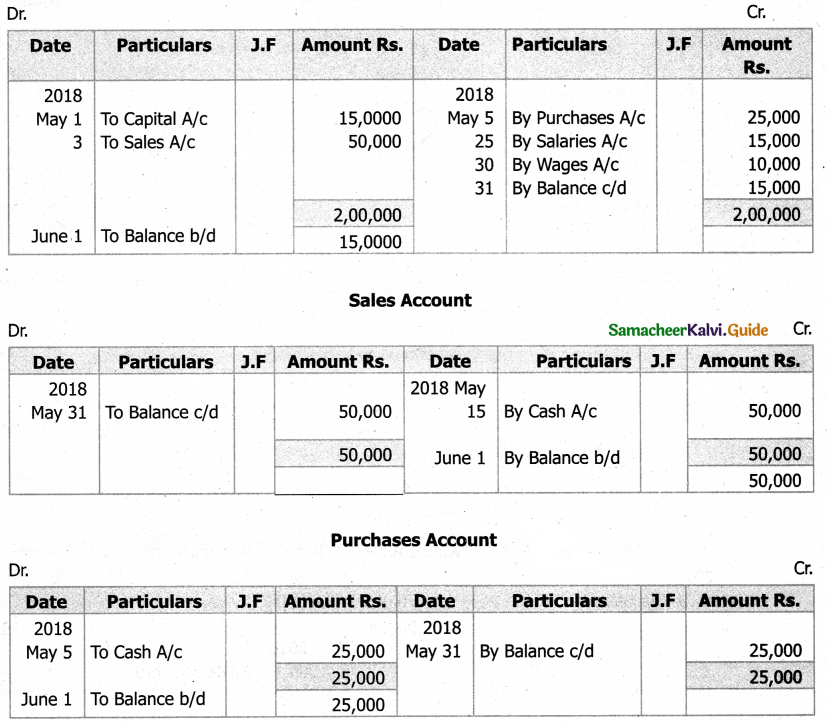
Capital Account
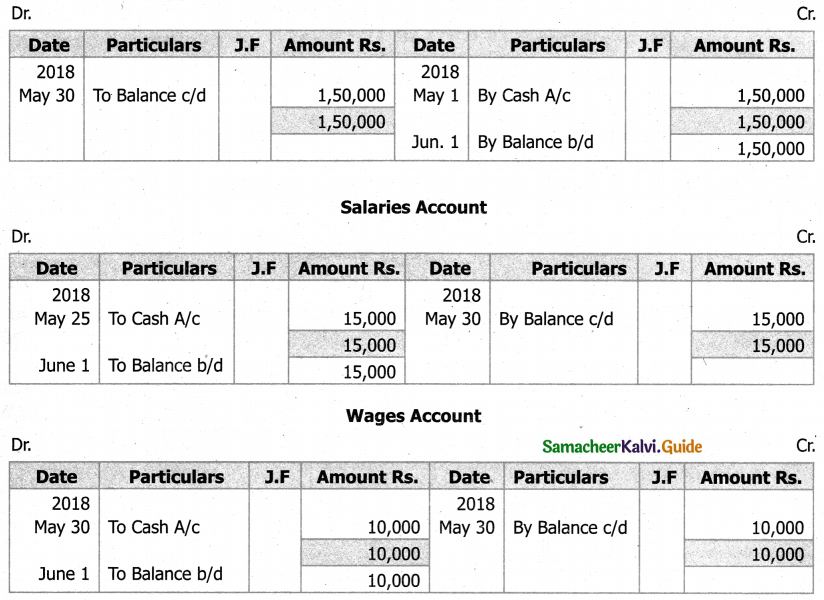
![]()